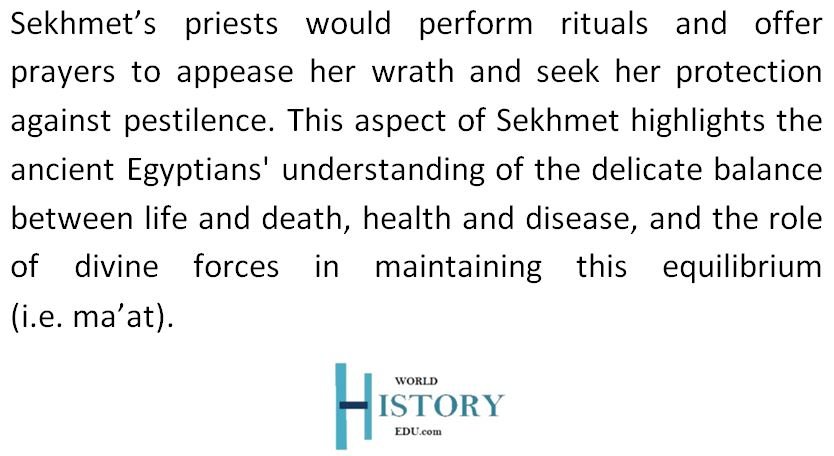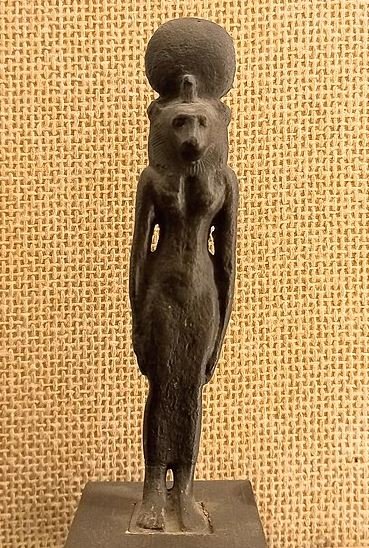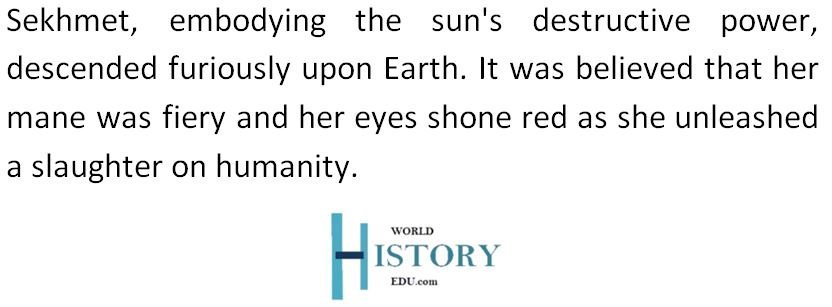How Sekhmet became both nurturing and destructive in the Egyptian pantheon
Sekhmet, often known as “the Bloodthirsty,” is a captivating figure from ancient Egyptian mythology who embodies the dual nature of being both a nurturing mother and a formidable adversary. Her name means “the Powerful One,” and she is typically depicted as a lioness or as a woman with the head of a lion, symbolizing her role as a goddess of war and destruction, as well as a protector.

Ancient Egyptian goddess Sekhmet exemplifies the multifaceted nature of the divine in ancient Egyptian religion, embodying extremes from nurturing motherhood to ruthless warfare.
Goddess of War and Destruction
Sekhmet is primarily known for her fierce and violent nature. According to myth, she was created by the sun god Ra from the fire of his eye to punish humankind for its sins. She became so consumed with bloodlust that she almost exterminated the entire human race. To stop her, Ra tricked her by dyeing beer red to resemble blood. Sekhmet drank the beer, became intoxicated, and ceased her slaughter.

Protective Mother and Healer
Despite her ferocity, Sekhmet also exhibits nurturing qualities. She is considered a protective goddess who wards off evil and illness. As a solar deity, she carries the destructive power of the sun but also its life-giving warmth. Sekhmet is associated with healing and medicine, believed to have control over diseases and to aid in cures. Physicians and healers often sought her assistance and protection in their work.

Feared and revered, Sekhmet could both spread and cure disease. This made her a powerful force in Egyptian mythology. Image: A wall relief sculpture, located at Temple of Kom Ombo in Egypt, depicting Sekhmet as a lioness.
Sekhmet – “The Lady of Pestilence”

Sekhmet’s fierce and destructive nature was believed to be necessary for maintaining cosmic order (i.e. ma’at), but it also needed to be carefully managed through rituals and offerings to prevent it from becoming overwhelmingly destructive.
It was believed that she sometimes resorted to harsh methods like plagues to manage population control, earning her titles such as “Lady of Pestilence” and “Red Lady” — the latter referring not only to blood but also to the red desert land.
Basically, angering Sekhmet could provoke devastating plagues and diseases, as she was believed to command these as her “messengers” or “slaughterers.”
Spiritual and Ritualistic Significance
Sekhmet held a significant place in royal and spiritual rituals, often invoked to protect the pharaoh and the nation during wars. Her priests were involved in rituals for healing and the preparation of medical remedies. Festivals in her honor involved music, dance, and drunken revelry as a reminder of her sedation by beer, symbolizing the restoration of balance and cessation of wrath.

Did you know…?
- At some temples, Sekhmet was offered the blood of sacrificed animals to placate her rage. This ritual was believed to contain her anger, granting her worshippers control over enemies and imbuing them with the strength to overcome illness and weakness.
- In Leontopolis, named “city of the lion” in Greek, tamed lions and lionesses were kept as living representations of Sekhmet, embodying her divine essence.
Complexity of Sekhmet’s Character
Sekhmet’s complex character as both a destroyer and a healer reflects the ancient Egyptians’ understanding of the dual nature of reality: life is both creative and destructive, and the divine can embody both aspects simultaneously. Her mythological stories emphasize the importance of balance and moderation in the face of overwhelming power or wrath.
FAQs
What is the meaning of her name?
Sekhmet’s name derives from “sekhem,” meaning “powerful” or “mighty,” with “-t” indicating femininity. Her epithets, such as “She Before Whom Evil Trembles,” “the eye of Ra”, “Mistress of Dread,” “The Mistress of Asheru”, “The Destroyer of Rebellion”, “The Mauler,” and “Lady of Slaughter,” reflect her fearsome aspects.
The above titles emphasize her role as a dominant force of destruction and protection, revered in Egyptian mythology for her power to both cause and repel violence and disease.
Sekhmet’s character serves as a powerful reminder of the potential for both creation and destruction inherent in the forces we revere and fear.
What is Sekhmet’s origin story?
According to the mythology, Sekhmet was created by the sun god Ra. She was also seen as both the wife of Ptah and the mother of Nefertum.
Additionally, she was the firstborn of the sun god Ra. During the New Kingdom period, when Memphis was the capital of Egypt, Sekhmet, along with Ra and Nefertum, was venerated as part of the “Memphite Triad.” This grouping reflected their combined attributes and importance in Egyptian religious life.

According to the Memphite Theology, detailed on the ancient Shabako Stone, Sekhmet, depicted as a lioness, was both the wife of Ptah, the patron of artisans, and the mother of Nefertum, the lotus god. Image: A sculpture Sekhmet located in India’s Albert Hall Museum.
How did the other gods trick Sekhmet?
The legend tells that in his old age, the sun god Ra believed that humanity was no longer respecting him or the gods, and their impiety was rampant. In response, Ra decided to punish mankind by sending an aspect of his daughter, the eye goddess Hathor, to earth as Sekhmet, a lioness, to exact vengeance.
As Sekhmet, she descended furiously upon the earth, her form representing the destructive power of the sun, with a mane like fire and eyes that blazed red. She began a slaughter of the human race, her bloodlust unquenched, reveling in the chaos she wrought.

The other gods, however, became alarmed as Sekhmet’s bloodshed threatened to exterminate all humanity. Ra, too, realized that his punishment had gone too far and sought to stop her before she annihilated every human being. He ordered that a large quantity of beer be brewed and dyed red with ochre or pomegranate juice to resemble blood. This concoction was poured over the fields around her.
Mistaking the beer for blood, Sekhmet drank it voraciously and became so intoxicated that she fell into a deep sleep, halting her rampage. When she awoke, her fury had dissipated, and she returned peacefully to Ra. This myth symbolizes the transformation of Sekhmet from a destructive force into a protective one, embodying the dual aspects of healing and destruction.
Alarmed by the extensive bloodshed threatening human extinction, the gods, including Ra, intervened. Ra concocted a plan involving beer dyed red with ochre or pomegranate juice, mimicking blood, which he spread across the fields.
How was she revered by Egyptian pharaohs?
Sekhmet’s fearsome reputation as a goddess of war and destruction logically made her a patroness of military endeavors among the Egyptian pharaohs. Many adopted her as a symbol of their martial prowess, believing she could breathe fire against their enemies.
During battles, flags and banners bearing Sekhmet’s image were carried to invoke her ferocity and protect the Egyptian armies. A notable statue at the Mut Temple in Karnak names her “Smiter of the Nubians,” highlighting her role in military campaigns.
Also, the hot desert winds were even thought to be her breath. It was also believed that she had the power to influence the outcomes of battles.

For example, Ramesses II (aka Ramesses the Great), embraced Sekhmet’s image, wearing it as a symbol of his warring power. In the friezes depicting the Battle of Kadesh at Karnak, Sekhmet is shown riding Ramesses’ horse, incinerating enemies with her flames.
In Old Kingdom writings, Sekhmet is noted as the mother of the lesser-known lion deity Maahes, who served as a protector of the pharaoh. The Pyramid Texts suggest that pharaohs were divinely conceived by Sekhmet, a belief visually supported by depictions of her nursing pharaohs like Nyuserra and Taharqo.
At the Temple of Seti I, a New Kingdom site, reliefs show the pharaoh nursed by Hathor, with an inscription labeling her as “mistress of the mansion of Sekhmet,” indicating a sacred connection between the two goddesses.
How did the Egyptians celebrate Sekhmet’s transformation?
Sekhmet’s transformation from a destructive force into a protective one is celebrated annually in the Festival of Drunkenness, which reenacts her pacification to remind of the need for balance and moderation. This festival not only marked the change from destruction to protection but also served as a ritual of healing and reconciliation, underscoring Sekhmet’s role as both a bringer of plague and a healer of ailments.
What is the relationship between Sekhmet and other ancient Egyptian goddesses?
The Egyptian pantheon featured many powerful goddesses, notably Isis and Hathor. Hathor, the goddess of love and music, was immensely popular and typically depicted as nurturing. However, in her wrathful aspect, she transformed into Sekhmet, the lioness known as ‘the Bloodthirsty.’
It has also been noted that starting around the Middle Kingdom, Egyptians began associating Sekhmet with Bastet, the cat goddess. Not only will Sekhmet take on some of the traits of Bastet, but she also took traits of other goddesses like Mut. It was also believed that Mut, who is one of the Theban triad in Upper Egypt, is the counterpart of Sekhmet, who was predominantly worshiped in Lower Egypt.
During festivals, statues of Sekhmet and Bastet, considered counterparts or twins in Egyptian mythology, were dressed and oriented symbolically: Sekhmet in red facing west, Bastet in green facing east. This ritual highlighted their duality—Sekhmet representing Upper Egypt’s chaotic, warlike nature, and Bastet symbolizing Lower Egypt’s tame, benevolent essence. This pairing underscored the significant concept of balance and contrast between chaos and order, war and peace, crucial in Egyptian belief systems.
How was Sekhmet depicted by the Egyptians?
Sekhmet represented the destructive side of the divine, feeding on the blood and fear of her enemies. In Egyptian art, she was shown as a woman with a lioness’s head, often with skin painted green like Osiris, symbolizing regeneration and the underworld. She carried an ankh and a lotus, symbols of life and purity, respectively, and wore a solar disk and uraeus, connecting her to the sun god Ra and royal authority.
What are some of the images of Sekhmet that have survived?
Numerous images of Sekhmet have survived from ancient Egypt, reflecting her importance and the reverence she commanded throughout the civilization’s history.
The most famous images of Sekhmet are perhaps the hundreds of black granite statues found in the funerary temple of Amenhotep III at Thebes. These statues, which are striking in their number and craftsmanship, depict Sekhmet seated, holding the ankh of life, and sometimes a scepter of papyrus. They were likely intended to invoke her healing power to counterbalance Amenhotep III’s ailments.
Smaller statues and figurines made of alabaster, bronze, and other materials also exist, often found in temples or as part of private devotional altars.
Sekhmet appears in temple reliefs and wall paintings, where she is often shown receiving offerings from pharaohs or participating in ritual activities. These images are commonly found in temples dedicated to her or where she figures prominently in the pantheon.
Images of Sekhmet were also painted or carved into the walls of some tombs, where she is depicted as a protector of the deceased, ensuring their safety in the afterlife.
Also, illustrations of Sekhmet can be found in some medical and magical papyri, where her role as a healer and a protector against evil forces is highlighted.
Sekhmet was also popularly featured on protective amulets, which were worn by the living or placed among the wrappings of mummies for protection against evil and disease.



























